Which translation of War and Peace should I read?
So you want to read Tolstoy’s best-known work, a thousand-page philosophical/historical epic encompassing hundreds of characters both real and fictitious, and you don’t read Russian.
Gotcha covered. Depending on how you count, there are between 5 and 11 complete English translations available to choose from.
War and Peace was first published in Russia serially, then published in its entirety in 1869. It was first translated into English (via French) by Clara Bell in 1886.
TLDR?
If you just want a quick-and-dirty recommendation on which translation to choose, jump to the conclusion. Otherwise, read on.
War and Peace: Translation History
I count 7 complete translations available in contemporary editions and 4 out of print.
- 1886 – Clara Bell
- 1889 – Nathan Haskell Dole
- 1904 – Leo Wiener
- 1904 – Constance Garnett
- 1923 – Aylmer and Louise Maude
- 1957 – Rosemary Edmonds
- 1966 – Maude revised by George Gibian
- 1968 – Ann Dunnigan
- 2005 – Anthony Briggs
- 2007 – Richard Pevear and Larissa Volokhonsky
- 2010 – Maude revised by Amy Mandelker
War and Peace: Miscellaneous Translations
Huntington Smith, starting with a French version, separated the “plot” of War and Peace from Tolstoy’s essay sections, which he grouped into a separate volume titled The Physiology of War. The two volumes were published in 1889.
An abridged translation by Princess Alexandra Kropotkin, English-born daughter of Russian anarchist Peter Kropotkin, was published in 1949.
Manuel Komroff produced an abridged version of Garnett’s text which served as the basis for the 1956 film starring Audrey Hepburn and Henry Fonda.
Alexander Bromfield translated an earlier (shorter and very different) manuscript of War and Peace. It was published in 2007 with the controversial title War and Peace: Original Version.
War and Peace: Translation Comparison
Extracts from the different translations of War and Peace are included below so that you can compare the language.
New England Review: “War and Peace in Our Time” by Michael R. Katz
Michael R. Katz, who is among the translators of Dostoevsky’s Crime and Punishment, does some careful spot-checking on four translations (Maude, Dunnigan, Briggs, and Pevear/Volokhonsky).
Los Angeles Times: “Echoes of Tolstoy” by Natasha Randall
“Translations are suspicious things. Which one should you trust? The answer is: none of them. What gets lost in translation? A lot. And a lot gets added. Translating is like mathematical division. One language just doesn’t always fit neatly into another, and you always have remainders. Whether it’s added nuance or missing nuance, English rarely fits perfectly into the space left by a Russian sentence…. All translations of War and Peace are difficult in some ways and marvelous in others. Awkward clauses tend to stick out in every translation; many feats of translation are easily passed over.”
New Yorker: “Movable Types” by James Wood
“Literary translators tend to divide into what one could call originalists and activists. The former honor the original text’s quiddities, and strive to reproduce them as accurately as possible in the translated language; the latter are less concerned with literal accuracy than with the transposed musical appeal of the new work. Any decent translator must be a bit of both.”
War and Peace: Structure
War and Peace is divided into four “volumes” that span fifteen “books”, each of which has numerous short “chapters”. There is also a two-part epilogue and sometimes an appendix by Tolstoy.
War and Peace: Use of French
Tolstoy has his characters occasionally use French in War and Peace, as it was normal for those people in those times to do so—and because he wanted to show how ironic it was.
Claremont Review of Books: “Puritans and Cavaliers” by Lesley Herrmann
“Most Russian readers in Tolstoy’s day would have understood French and caught the irony of a Russian aristocracy speaking and writing French among themselves, even as they were fighting a war with France.”
New York Review of Books: “Tolstoy’s Real Hero” by Orlando Figes
“In the original (1868–1869) edition Tolstoy translated the foreign passages into Russian in footnotes, but in the revised 1873 edition he cut out all the French (‘I think it is better without it,’ he wrote to the critic Nikolai Strakhov), only to restore it in the later editions.”
Some English editions leave the French passages in French, offering the reader no assistance whatsoever; some translate the French into English and put the French in a footnote for reference; some translate the French but add some indication of which text was originally in French; and some silently translate all the French into English, leaving only a few scattered words in French as a kind of flavoring.
Who was Clara Courtenay Poynter Bell?
Clara Bell was a prolific professional English translator fluent in various European languages, notably French and German.
About the Bell translation of War and Peace
Bell based her English translation on a French translation by “a Russian Lady”.
Extract from the Bell translation of War and Peace
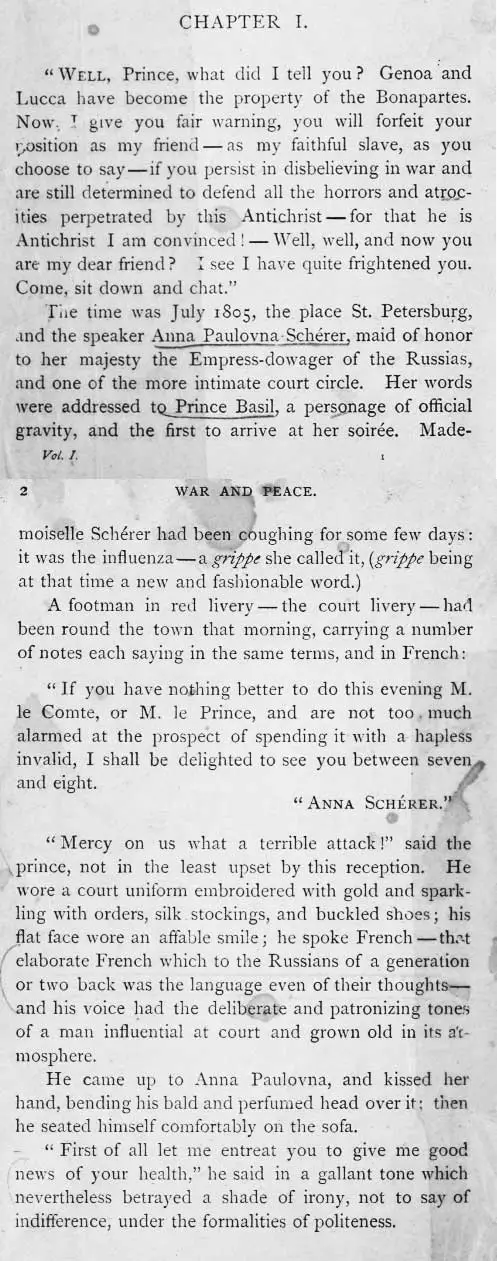
Get the Bell translation of War and Peace
Her translation was published in six separate physical volumes.
I found full scans freely available from Google Books.
Who was Nathan Haskell Dole?
He was an American editor and author who translated works from Russian, Spanish, French, and Italian. He edited a twenty-volume edition of the collected works of Tolstoy. Some of his translations and at least one original work of his own are available at Gutenberg.org.
If you’re a New York Times subscriber, you can read his NYT obituary.
New England Review: “War and Peace in Our Time” by Michael R. Katz
The second War and Peace translation was carried out by “Nathan Haskell Dole, an extraordinary character, writer, and journalist, whose apparent lack of skill in the enterprise was such that Tolstoy himself felt compelled to beg him to stop translating his works.”
About the Dole translation of War and Peace
Patrick Crabtree’s Blog: “Which translation of War and Peace should I read?”
“[I]f you’re not a Russophile you might miss some of his more subtle entries and meanings and you might view many of his words as archaic.”
From Dole’s introduction:
The present translation has been made from the original Russian. Tolstoi has been felicitously called “the Russian Rembrandt.” It is not fair to reproduce Rembrandt as a Teniers. The French versions of Russian are apt to smooth and weaken the bluntness and vigor of the original. Count Tolstoi days : “On pashol.” The French expands this, which simply means ”He went out,” into “Apres avoir exhale sa colere, il s’en alla chez lui,” ten words for two. One may be sometimes tempted to substitute the curved line of beauty for the straight line of duty, or soften a harsh silhouette, but beyond certian unavoidable issues of the sort necessary for reproducing the impression given by the original, the translator ought to be as faithful as possible. Here the old law of an eye for an eye and a tooth for a tooth, repudiated by Count Tolstoi, ought to have a new application!
A list of the characters has been added for convenience of reference, and at the end of the work will be found a synopsis of the story. For the amusement or gratification of the cultured reader, some of the polyglot conversation so characteristic of the story, as it was characteristic of educated Russians two generations ago, has been relegated to foot notes.
Extract from the Dole translation of War and Peace
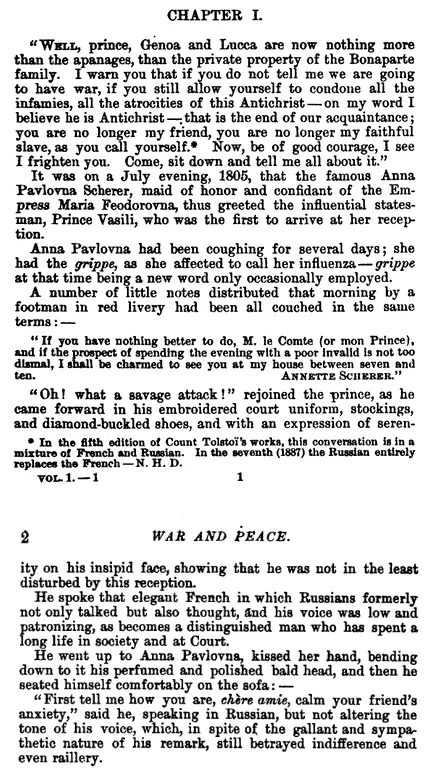
Get the Dole translation of War and Peace
There are four volumes. Here are links to scans at Archive.org:
Who was Leo Wiener?
He was a foreign-born assistant professor of Slavic languages at Harvard University. In fact, according to Wikipedia, he was the first American professor of Slavic literature. He is responsible for a limited-edition, illustrated, 24-volume Complete Works of Tolstoy project published by Dana Estes and Company in Boston.
About the Weiner translation of War and Peace
Starting from page 1, it contains untranslated French text.
Extract from the Weiner translation of War and Peace
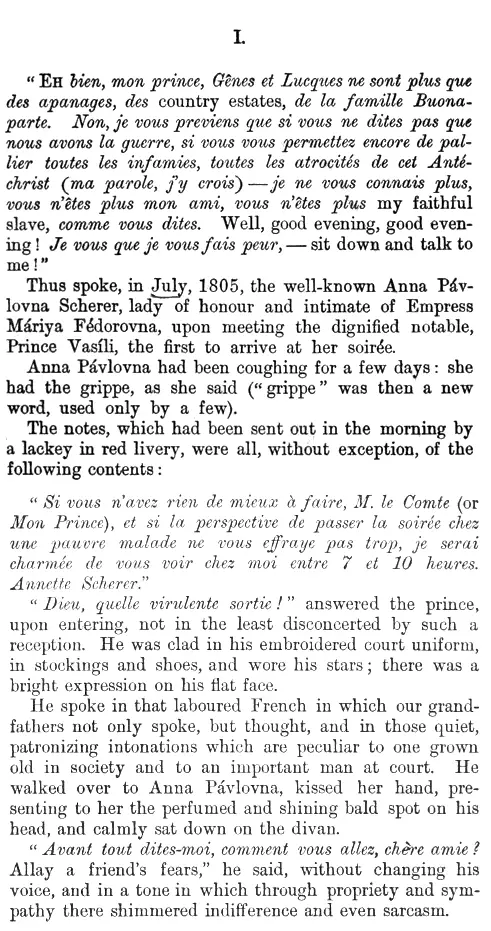
Get the Weiner translation of War and Peace
There are four volumes. Here are links to scans at Archive.org.
Who was Constance Garnett?
She was responsible for translating seventy works of Russian prose into English for the first time. Many are available free for download at Gutenberg.org.
Whenever her name pops up, you will hear people echoing complaints by D.H. Lawrence, Nabokov and Brodsky. You will also hear people who say that Garnett’s groundbreaking, sensitive translations (which have been updated to remedy obvious flaws) will never go out of style.
Garnett started losing her eyesight while working on War and Peace. She continued her translation work by hiring a secretary to read out the Russian aloud and write down her English rendering.
She is among the translators of Dostoevsky’s Crime and Punishment, The Brothers Karamazov, and The Possessed (Demons), Notes from Underground, and Tolstoy’s Anna Karenina.
About the Garnett translation of War and Peace
Garnett translates the French into English.
Patrick Crabtree’s Blog: “Which translation of War and Peace should I read?”
“I found her work to be by far the most lyrical and poetic of them all. There are episodes in this book where Tolstoy has executed pure magic with his word painting and Garnett nails these inspired moments like no other.”
Five Books: “Which translation of War and Peace should I read?” by Rosamund Bartlett
Garnett “was largely self-taught, and worked without the arsenal of dictionaries and resources available in abundance today, not to mention the benefit of hindsight. Her translation of War and Peace is ultimately a little too Edwardian, and lacks precision.”
Extract from the Garnett translation of War and Peace
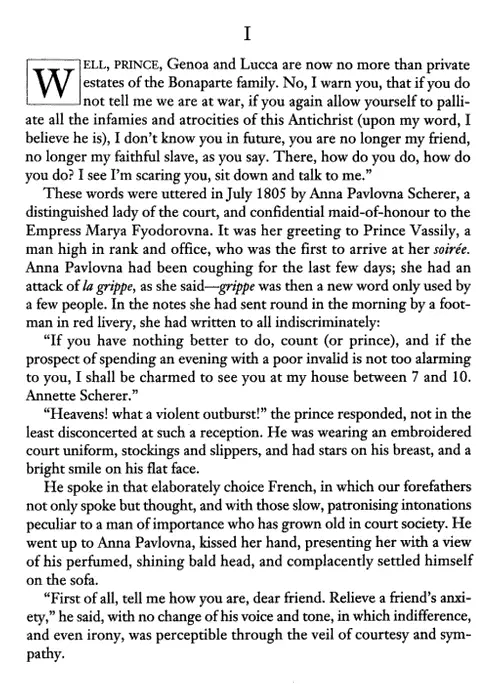
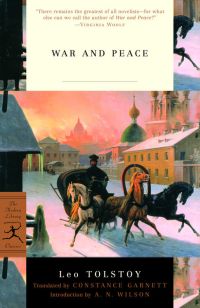
Get the Modern Library Classics Garnett translation of War and Peace
Includes an introduction by A.N. Wilson, a biographical note, and a reading group guide.
Available as a paperback (ISBN 9780375760648, 1424 pages).
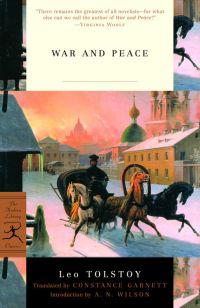
Get the Modern Library Classics Garnett translation of War and Peace
Includes an introduction by A.N. Wilson, a biographical note, and a reading group guide.
Available as an ebook (ISBN 9780307820396).
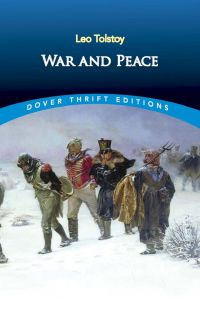
Get the Dover Thrift Editions Garnett translation of War and Peace
Reprint of the Carlton House, New York, 1940 edition. Also available as an ebook directly from Dover Thrift Editions.
Available as a paperback (ISBN 9780486816432, 1152 pages).
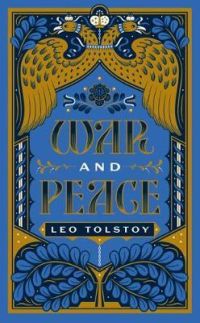
Get the Barnes & Noble Collectible Editions Garnett translation of War and Peace
Bonded leather, gilt-edged pages and ribbon marker. From looking at Amazon reviews, I think the text is complete but veerrrry squeezed. I'm not 100% sure which translation this is; probably Garnett as the other Barnes & Noble book is Garnett.
Available as a hardcover (ISBN 9781435169876, 896 pages).
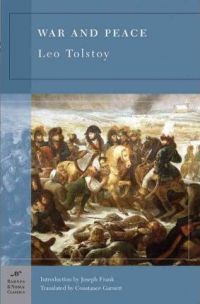
Get the Barnes & Noble Classics Garnett translation of War and Peace
Includes a brief biography, a section on historical background, an introduction by Joseph Frank, a list of characters, endnotes, information on adaptations, comments and questions, and a list for further reading. Also available as a Nook ebook (ISBN 9781411433717).
Available as a paperback (ISBN 9781593080730, 1200 pages).
Who were Louise and Aylmer Maude?
They were a Russian-speaking British couple who were friends of Tolstoy. Aylmer Maude wrote his biography. Tolstoy is on the record as heartily approving their efforts to transmit his words and ideas to others:
Better translations, both for knowledge of the two languages and for penetration into the very meaning of the matter translated, could not be invented.
About the Maude translation of War and Peace
The Maude translation lives on in a variety of editions, in part because of Tolstoy’s official approval, in part because it is now off copyright and thus fair game for publishers to print and reprint as much as they like, and finally because it is actually good.
The Maude translation of War and Peace has been thoroughly edited and re-released twice; see below for information on the revised Gibian and Mandelker editions.
The original Maude translation silently rendered all French text in English, Anglicized Russian names, and added chapter headings, all of which was designed to make the text more accessible in English, but was subsequently criticized for making the text less authentic.
Some Maude editions may include maps drawn by Tolstoy.
New England Review: “War and Peace in Our Time” by Michael R. Katz
“[T]he Maudes’ translation is generally serviceable, but it contains occasional errors and numerous examples of passages where they altered or ‘improved on’ the style of the original.”
Claremont Review of Books: “Puritans and Cavaliers” by Lesley Herrmann
“My copy of the Maude translation was published in 1942 by Simon & Schuster for a reprint series called Inner Sanctum Books for Victory. Appearing at the height of the Second World War, it contains a map of Europe showing Napoleon’s invasion and retreat from Russia—overlaid with a nearly identical map of Hitler’s assault in 1941-42, a dramatic reminder of the importance of geography.”
Extract from the Maude translation of War and Peace
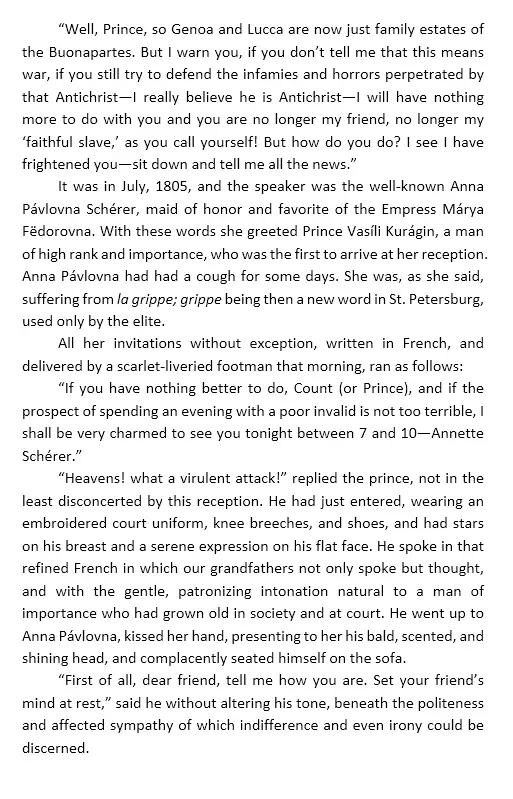
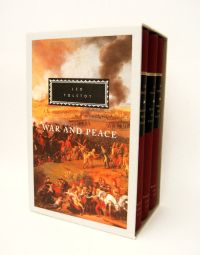
Get the Everyman's Library Maude translation of War and Peace
Includes an introduction by R.F. Christian, a bibliography, a chronology, a list of principal characters, a table of dates, a couple of maps, and Tolstoy's appendix.
Available as a three-volume hardcover boxed set (ISBN 9780679405733, 1678 pages).
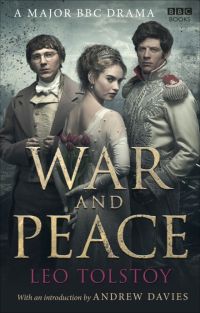
Get the BBC Books Maude translation of War and Peace
Includes an introduction by Andrew Davies. Also available as an ebook (ISBN 9781448142675).
Available as a paperback (ISBN 9781849908467, 1008 pages).
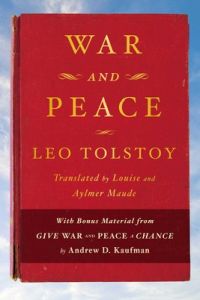
Get the Simon & Schuster Maude translation of War and Peace
Includes bonus material from Give War and Peace A Chance by Andrew D. Kaufman.
Available as an ebook (ISBN 9781476789477, 1400 pages).
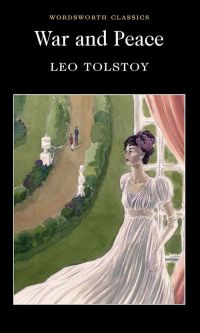
Get the Wordsworth Classics Maude translation of War and Peace
Includes an Introduction by Henry and Olga Claridge.
Available as a paperback (ISBN 9781853260629, 1024 pages).
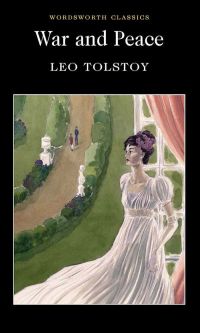
Get the Wordsworth Classics Maude translation of War and Peace
Includes an Introduction by Henry and Olga Claridge.
Available as an ebook (ISBN 9781848703827).
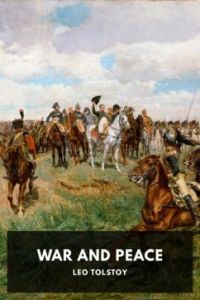
Get the Standard Ebooks Maude translation of War and Peace
Includes a list of characters. 570,061 words (34 hours 33 minutes) with a reading ease of 69.41 (fairly easy).
Available as an ebook.
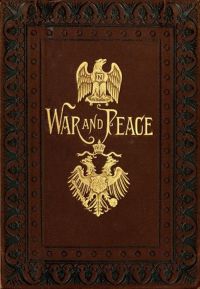
Get the Project Gutenberg Maude translation of War and Peace
The text of the novel, nothing more.
Available as an ebook.
Who was Rosemary Edmonds?
She was a British translator of Russian literature. She translated Russian classics by Pushkin, Turgenev, Gogol, Leskov, and Tolstoy.
About the Edmonds translation of War and Peace
Patrick Crabtree’s Blog: “Which translation of War and Peace should I read?”
“It is conveyed in straight English with no bothersome footnotes for the English translation of French entries…. I liked how Edmonds handled situations such as German accents…. This is also the translation which served as the basis for the BBC mini-series starring Anthony Hopkins.”
Mirabile Dictu: “Is Rosemary Edmonds’ Translation the Best?” by Kat
“I am enraptured by her prose. Her style is simple and graceful, neither too literary nor too literal. It lies somewhere between the Edwardian elegance of the Maudes and the deliberately rough fidelity of Pevear and Volokhonsky to Tolstoy’s allegedly awkward syntax and inelegant repetitions.”
Extract from the Edmonds translation of War and Peace
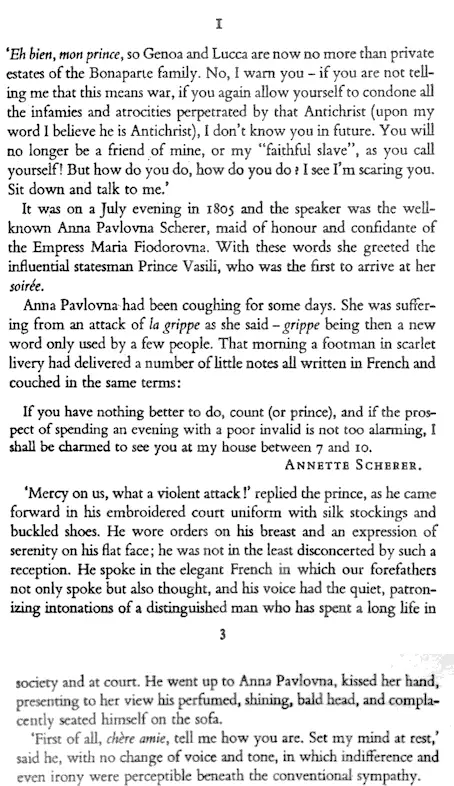
Get the Edmonds translation of War and Peace
It was published by Penguin in 1957 and revised in 1978. It’s no longer in print, but there are used copies floating around. Older editions are split into two volumes.
Who was George Gibian?
He was a writer, editor, translator, and distinguished professor of Russian and comparative literature at Cornell University. He edited 20 books and published 90 articles in total. He died in 1999.
Read the Cornell University Faculty Memorial Statement.
He was born in Prague, studied in England, fought in WWII, earned a PhD in English from Harvard, and taught at Smith, Amherst, UC Berkeley and Cornell.
About the Gibian / Maude translation of War and Peace
Consists of an updated version of the Maude translation plus notes.
The French parts are translated into English.
Also includes three maps, backgrounds and sources, selections from Tolstoy’s letters and diaries, three drafts of his introduction to the novel, an 1868 article by Tolstoy in which he reacts to his critics, a chronology, a selected bibliography, and twenty essays
Extract from the Gibian / Maude translation of War and Peace
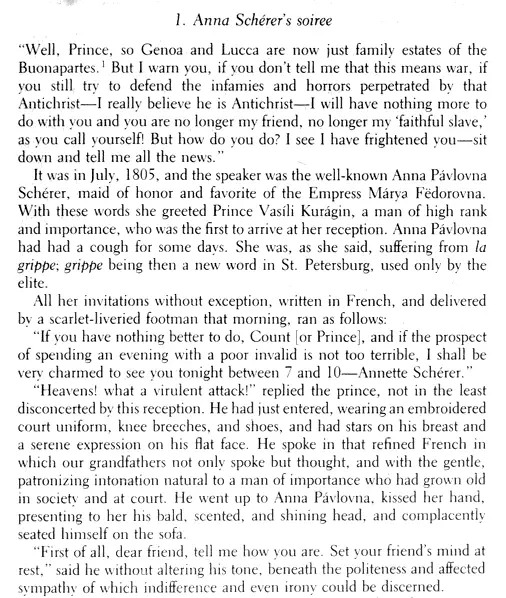
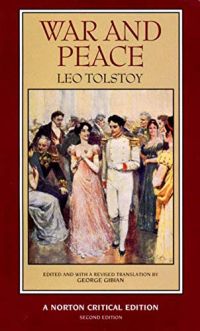
Get the Norton Critical Edition Maude/Gibian translation of War and Peace
Includes three maps, backgrounds and sources, selections from Tolstoy’s letters and diaries, three drafts of his introduction to the novel, an 1868 article by Tolstoy in which he reacts to his critics, a chronology, a selected bibliography, and twenty essays that provide diverse perspectives on the novel by Nikolai Strakhov, V. I. Lenin, Henry James, Isaiah Berlin, D. S. Mirsky, Kathryn Feuer, Lydia Ginzburg, Richard Gustafson, Gary Saul Morson, and Caryl Emerson, among others.
Available as a paperback (ISBN 9780393966473, 1200 pages).
Who was Ann Dunnigan?
Ann Dunnigan Kennard, an American born in California, worked in theater and as a teacher. She translated works by Chekhov, Tolstoy, and Dostoyevsky. She died in 1997.
New York Times: “Ann Dunnigan, Actress and Translator, 87”
About the Dunnigan translation of War and Peace
Includes an introduction by Pat Conroy, a note on the text, a list of chief families, an afterword by John Hockenberry, and a selected bibliography.
There are scattered French words in the text but no long passages.
Patrick Crabtree’s Blog: “Which translation of War and Peace should I read?”
“I found the translation itself to be quite competently rendered and most of the text reads straight through with no footnotes to deal with for the French language parts.”
New England Review: “War and Peace in Our Time” by Michael R. Katz
“Dunnigan’s version seems too derivative from the Maudes, even to the point of repeating some of their most egregious errors, and she offers very little in the way of significant improvement.”
Commentary Magazine: “The Pevearsion of Russian Literature” by Gary Morson
Morson is vehemently NOT a fan of translations by Pevear and Volokhonsky. In this article, among other things, he praises a passage from Dunnigan’s War and Peace.
Extract from the Dunnigan translation of War and Peace
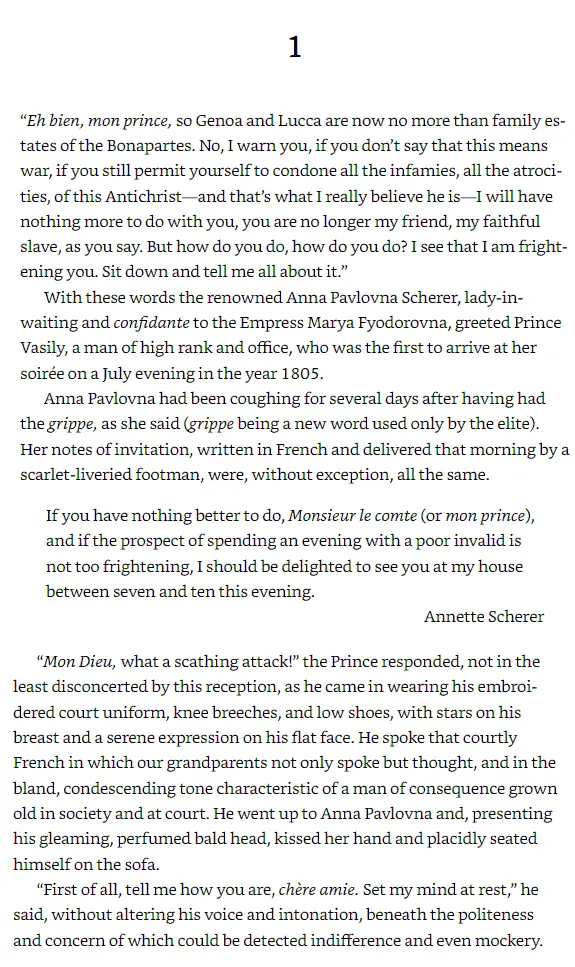
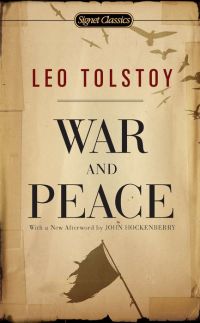
Get the Signet Classics Dunnigan translation of War and Peace
Includes an introduction by Pat Conroy, a note on the text, a list of chief families, an afterword by John Hockenberry, and a selected bibliography.
Available as an ebook (ISBN 9781101003831).
Who is Anthony Briggs?
Anthony Briggs is a British scholar who has extensive experience writing, editing, and translating works in Russian, particularly by Tolstoy and Pushkin.
About the Briggs translation of War and Peace
The Briggs translation aims at accessibility, but is too aggressively modernized and British for some tastes. It includes an introduction and notes and an afterword by Orlando Figes. Briggs translates the French into English. Includes versions of Tolstoy’s maps.
The Atlantic: “Found in Translation” by Mona Simpson
Briggs says his translation corrects excessively feminine tendencies among previous translators. “I find it charmingly hilarious that a translator will work through a 1,358-page book with the hope that the insertion of slang will bring the novel he’s long loved to new mass audiences. ”
New England Review: “War and Peace in Our Time” by Michael R. Katz
“It has several useful aids for the reader: a sixteen-page chapter by chapter summary of the action; brief factual descriptions of three key battles (Schöngrabern, Austerlitz, and Borodino); fifteen pages of footnotes; a list of the novel’s main characters; and several helpful maps.”
The Guardian: “A Masterpiece in Miniature” by Adam Thirlwell
“Anthony Briggs claims Leo Tolstoy is comparatively easy to translate. Adam Thirlwell is a little suspicious of his version of War and Peace.”
New England Review: “War and Peace in Our Time” by Michael R. Katz
“Briggs’s language comes across as far too ‘British’ for American readers; he adds unneeded qualifiers, strains for original synonyms that distort Tolstoy’s meaning, and ignores certain repetitions that have essential thematic significance.”
The New Yorker: “The Translation Wars” by David Remnick
“Rosemary Edmonds, the last translator of the novel, had as ‘It serves them right, the b—— b——s!’ Briggs has as ‘They asked for it, the fucking bastards!’ ”
Five Books: “Which translation of War and Peace should I read?” by Rosamund Bartlett
“The new Penguin Classics edition by Anthony Briggs, published in 2005, breathes new life into War and Peace, but not all have warmed to its contemporary colloquialisms and British idioms.”
Claremont Review of Books: “Puritans and Cavaliers” by Lesley Herrmann
“Briggs aimed for English that occurs naturally in its context and now sounds appropriate, and he produced a fluid, enjoyable, colloquial—and definitely modern—British version…. The cavalier Briggs provides synonyms to cure the repetitions, breaks up Tolstoy’s run-on sentences, and adds modern colloquialisms.”
Extract from the Briggs translation of War and Peace
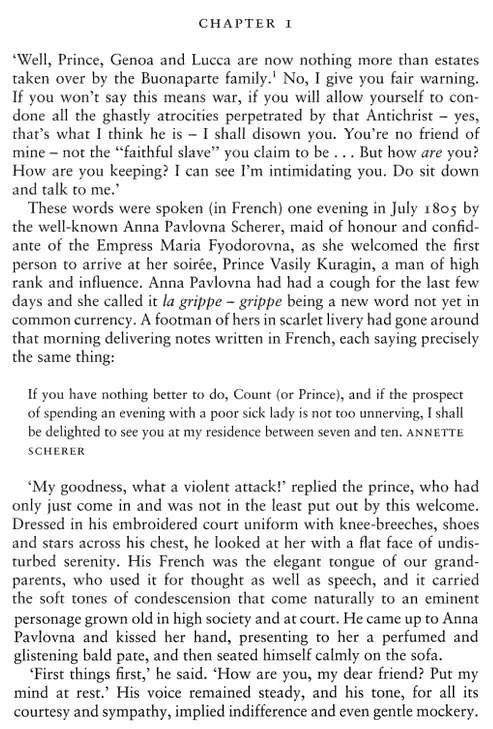
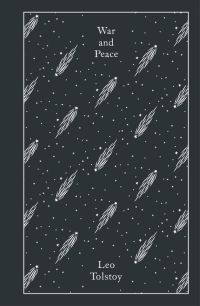
Get the Penguin Clothbound Classics Briggs translation of War and Peace
Includes an introduction by Antony Briggs and an afterword by Orlando Figes. Cover designed by Coralie Bickford-Smith.
Available as a hardcover (ISBN 9780241265543, 1440 pages).
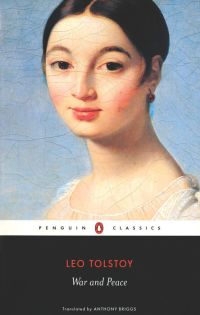
Get the Penguin Classics Briggs translation of War and Peace
Includes an introduction and notes by Antony Briggs and an afterword by Orlando Figes. Cover designed by Coralie Bickford-Smith.
Available as a paperback (ISBN 9780140447934, 1440 pages).
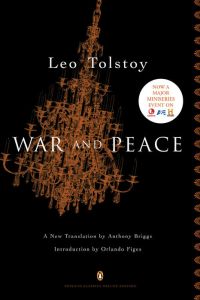
Get the Penguin Classics Deluxe Briggs translation of War and Peace
Includes an introduction by Antony Briggs and an afterword by Orlando Figes.
Available as a paperback (ISBN 9780143039990, 1424 pages).
Who are Richard Pevear and Larissa Volokhonsky?
They are a husband and wife translation team known for their prize-winning translations from Russian. Their method is for Volokhonsky (the Russian expert) to produce a literal English version for Pevear (the English expert) to edit and then discuss with her, further rounds of writing and editing being undertaken as needed. They have translated works by Dostoevsky, Gogol, Pasternak, Pushkin, Chekov, and Turgenev as well as Tolstoy. Their literary success was kicked up several notches when Oprah chose their translation of Anna Karenina for her book club.
As is often the case with popular cultural products, opinions are starkly divided on the quality of their work: some have praised their unusual syntax and word choice, said to be refreshingly and absolutely authentic, while others have found it needlessly and terribly awkward.
They are among the translators of Crime and Punishment , The Brothers Karamazov, The Idiot, Demons, Notes from Underground, and The Master and Margarita. Separately, Pevear has also translated works in French, Italian, Spanish, and Greek, including The Three Musketeers.
About the Pevear and Volokhonsky translation of War and Peace
The translation is characterized as intentionally word-for-word.
French passages are left in place but have English translations in footnotes, as shown on page 1.
Includes an introduction by Richard Pevear, a list of principal characters, Tolstoy’s appendix, endnotes, historical index, and summary. Lacks maps.
Los Angeles Times: “Echoes of Tolstoy” by Natasha Randall
“Pevear and Volokhonsky have mastered Tolstoy’s shorter lines, his elliptical impressions.”
New England Review: “War and Peace in Our Time” by Michael R. Katz
“[T]his is a very serious translation, imposing the greatest demands upon the reader. By way of assistance, however, the translators do provide a list of the principal characters, with notes on their Russian names; a comprehensive set of annotations (twenty-five pages); a historical index of important people and places (fifteen pages); a summary of the content of chapters (ten pages); and, finally, an 1868 preface by Tolstoy himself.”
New England Review: “War and Peace in Our Time” by Michael R. Katz
“Pevear and Volokhonsky manage to preserve most of Tolstoy’s stylistic originality, both semantic and syntactic. Their efforts convey a much closer equivalent in English to the experience of reading War and Peace in the original.”
New York Review of Books: “Tolstoy’s Real Hero” by Orlando Figes
“[Pevear and Volokhonsky restored] all the characteristic idioms, the bumpy syntax, the angularities, and the repetitions that had largely been removed in the interests of ‘good writing’ by Garnett and her followers…. What really makes this wonderfully fresh and readable translation stand out from its predecessors is its absolute fidelity to the language of Tolstoy…. The Russian language is the real hero of Tolstoy’s masterpiece; it is his voice of truth. The English-speaking world is indebted to these two magnificent translators, Richard Pevear and Larissa Volokhonsky, for revealing more of its hidden riches than any who have tried to translate the book before.”
Five Books: “Which translation of War and Peace should I read?” by Rosamund Bartlett
The Pevear and Volokhonsky translation is “faithful to Tolstoy’s idiosyncracies, but the resulting English prose can be highly un-idiomatic and thus somehow falls short of the majesty of the original.”
Claremont Review of Books: “Puritans and Cavaliers” by Lesley Herrmann
“Cavaliers translate freely; puritans stress fidelity to the text. Richard Pevear and Larissa Volokhonsky, the newest translators of War and Peace, are puritans. They seek to capture’the balance, rhythm, and above all the repetitiveness'” of Tolstoy’s style. The result is as close to Tolstoy’s original as one can get without reading Russian.”
The Open Mic: “Literary Translation: How to Get Rich and Famous” by E.S. Dempsey
“[I]n Tolstoy’s War and Peace there are phrases and even a speech that appeared in French in the Russian original. Most English translators have brought it all into English. But Volokhonsky had other ideas. ‘Tolstoy used French for a reason, or for several reasons: to give the tone of the period; to play on the ironies of a French-speaking Russian aristocracy suddenly finding itself thrown into war with France; to suggest a certain frivolity and uprootedness in characters like Prince Vassily and the witty Bilibin.'”
Extract from the Pevear and Volokhonsky translation of War and Peace
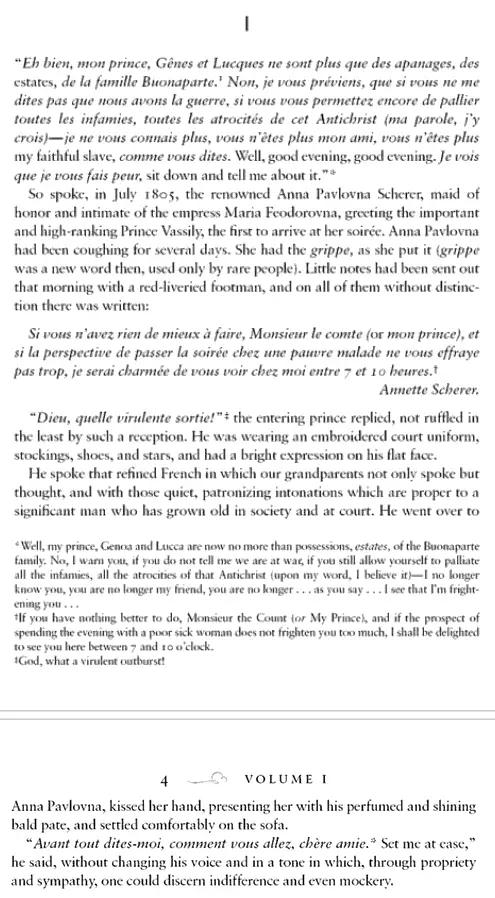
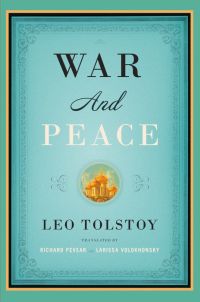
Get the Vintage Pevear and Volokhonsky translation of War and Peace
Includes an introduction by Richard Pevear, a list of principal characters, Tolstoy's appendix, endnotes, historical index, and summary. Also available as an ebook (ISBN 9780307806581).
Available as a paperback (ISBN 9781400079988, 1296 pages).
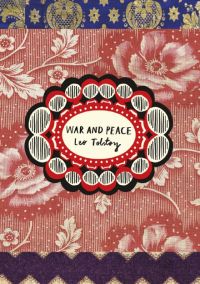
Get the Vintage Classic Russians Pevear and Volokhonsky translation of War and Peace
Possibly also available as an ebook (ISBN 9781446484166).
Available as a paperback (ISBN 9781784871949, 1296 pages).
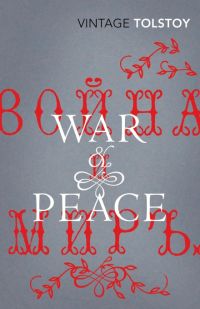
Get the Vintage Classics Pevear and Volokhonsky translation of War and Peace
Includes an introduction by Richard Pevear, a list of principal characters, Tolstoy's appendix, endnotes, historical index, and summary.
Available as a paperback (ISBN 9780099512240, 1296 pages).
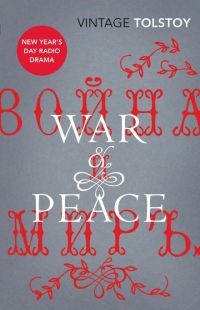
Get the Vintage Classics Pevear and Volokhonsky translation of War and Peace
Includes an introduction by Richard Pevear, a list of principal characters, Tolstoy's appendix, endnotes, historical index, and summary.
Available as a hardcover (ISBN 9780099512233, 1296 pages).
Who is Amy Mandelker?
Amy Mandelker is a professor of comparative literature at the Graduate Center of the City University of New York. She writes on Russian literature and literary theory and was the editor of the Tolstoy Studies Journal.
Check out her audio guide to War and Peace and her post on War and Peace film adaptations.
About the Mandelker translation of War and Peace
From the publisher: “Based on the famed Maudes’ translation — long seen as the finest available — this edition is lightly updated to be even more readable, to restore passages in French, and to use the original Russian spelling of names.”
Includes an introduction by Amy Mandelker, notes, lists of historical characters and the fictional families, a chronology of Tolstoy and of historical events in the novel, five maps, and Tolstoy’s appendix.
Five Books: “Which translation of War and Peace should I read?” by Rosamund Bartlett
Bartlett, one of the translators of Tolstoy’s Anna Karenina, calls the Oxford edition of War and Peace ‘definitive’. “With the publication by Oxford World’s Classics in 2010 of a carefully revised edition of the Maude translation, it is now possible to recommend it unequivocally.”
Extract from the Maude/Mandelker translation of War and Peace
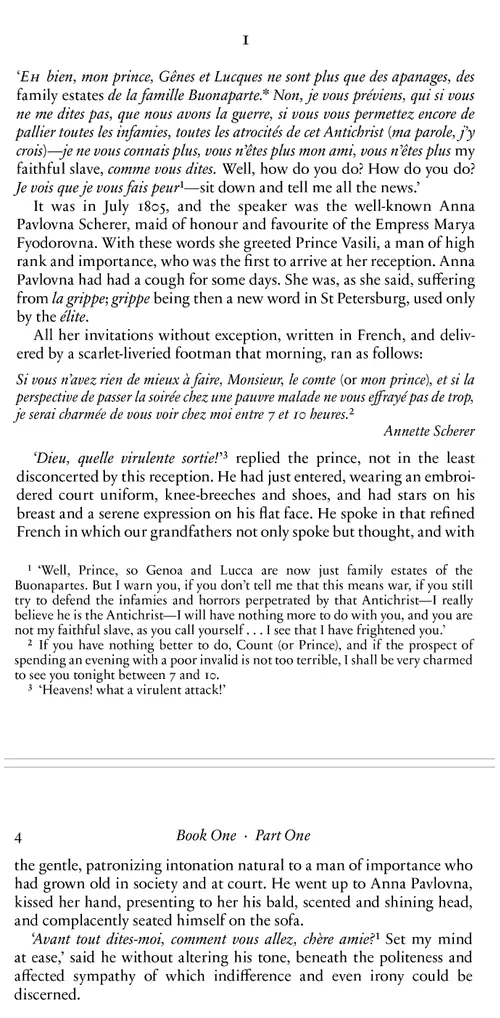
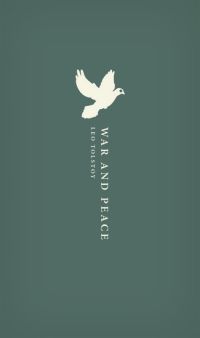
Get the Oxford World's Classics Maude/Mandelker translation of War and Peace
Includes an introduction by Amy Mandelker, notes, lists of historical characters and the fictional families, a chronology of Tolstoy and of historical events in the novel, five maps, and Tolstoy's appendix.
Available as a hardcover (ISBN 9780198800545, 1392 pages).
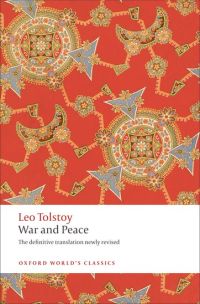
Get the Oxford World's Classics Maude/Mandelker translation of War and Peace
Includes an introduction by Amy Mandelker, notes, lists of historical characters and the fictional families, a chronology of Tolstoy and of historical events in the novel, five maps, and Tolstoy's appendix.
Available as a paperback (ISBN 9780199232765, 1392 pages).

Get the Oxford World's Classics Maude/Mandelker translation of War and Peace
Includes an introduction by Amy Mandelker, notes, lists of historical characters and the fictional families, a chronology of Tolstoy and of historical events in the novel, five maps, and Tolstoy's appendix.
Available as an ebook (ISBN 9780199232765).
War and Peace: Best Translation?
People have different purposes in reading, and different esthetic taste, but here’s what I recommend based on what I’ve learned about the available War and Peace translations.
My first choice would be the Maude/Mandelker translation. This edition from Oxford is now the most recent, and seems like a good balance between smooth, non-modernized English and text updated to correct errors. It contains notes and other reader aids, and is available as a hardcover, paperback, or ebook. Tolstoy himself approved of the Maude translation. Contains French passages with English in the footnotes.
Fans of Pevear & Volokhonsky will choose theirs, as it claims to be the most authentic, albeit at the cost of smoothness. Contains French passages with English in the footnotes.
If you don’t want old-fashioned language and you don’t want a raw literal translation, try Briggs. (No French passages.)
If you want to read the book for free or as cheaply as possible, look for a copy of the original Maude text. (No French passages.)

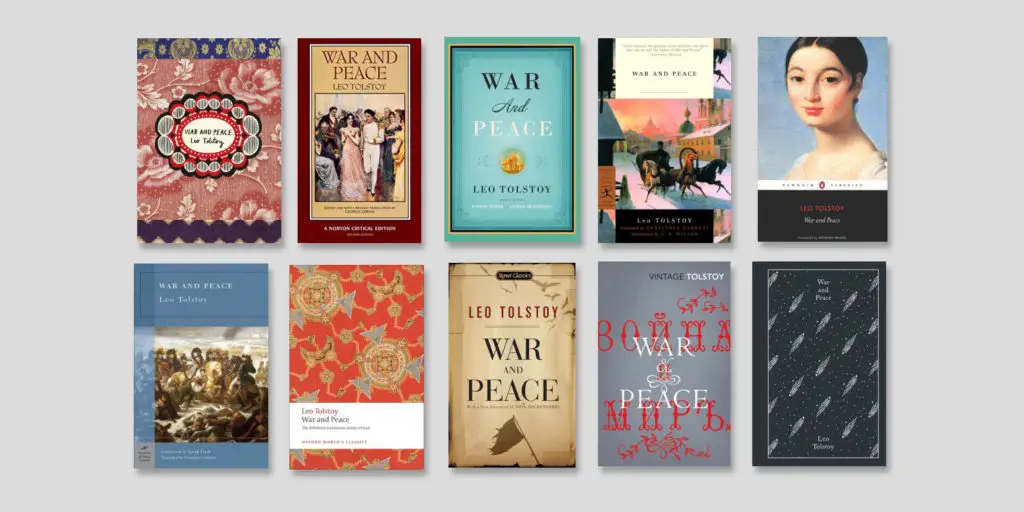
Decades ago, I first read War and Peace using the Garnett translation. I didn’t find anything wrong with it; it was fine – I got through it but was troubled by the names. Now there are more trendy translations which I might try next. I found that the Maude edition didn’t flow as well as Garnett, however, I found the Medelker revision a bit better. The Briggs reads well but has its idiosyncrasies.
I wish to read War and Peace first time.How I tackle and keep in mind many characters in the novel .Want to read in English which is my second language.Need your valuable advice .
That’s a great goal! There are many study guides online that have lists of characters and descriptions of who they are. Unfortunately, those lists might tell you what will happen in the book before you read about it. I think the best way to keep track of the characters is to make your own notes as you read. You can make simple lists and continuously add details. Some family tree drawings will probably also help. Keep in mind that the same character may be referred to by different parts or versions of his or her name. There will probably be a simple list of characters included in the front of the book itself. Good luck and happy reading!
I began reading the Constance Garnett version but decided to change to the Maude version. What a difference! It’s so smooth: it just pulls you deeper and deeper into the novel. I’m glad I changed.
i just happened to pick the Briggs translation at Borders (remember that?) and have since read W&P maybe 5-6 times over the years. Reading W&P got me into Russian literature and then into realizing how important translation was, especially at the same time I was attempting to learn Japanese. I think tolstoytherepy.com has comparisons of all the W&P editions and the only one I cannot stand is the P&V version.
their media push is an obvious case of media hype to sell books that are already widely available in cheaper and better translations. i’m not sure if i would have finished W&P with the P&V edition. ‘its supposed to be clunkly!’, okay, well why did Tolstoy read and approved the Maude version? (I think it was that version anyway). I keep hoping that Briggs will do Anna Karenina or his short stories but so far nothing. Don’t get me wrong I loved my maude edition but since Briggs impressed me so much with W&P I’d love to see his take on a translation.
But at the end of the day as long as people like what they read that’s all that matters. But I agree w/ an article that said students/first time readers being put off/getting the wrong idea about famous Russian novels because of P&Vs clunky, awkward avant-guard way of translating. Honestly I’d give first time readers the Briggs edition….I know I’m biased but still….it reads sooo good! makes the novel come alive. P&V I’m questioning if I’m reading English or not lol.
Why does the original Maude have additional chapters? For example volume 1, book 1, has 28 chapters?
My first experience with War and Peace came when I was in high school and read an abridged (book club edition). I loved it. Later, in college, I read the Garnett version for a class so read the book several times to prepare for class. It was at that time that I read Nabokov’s Pnin where Professor Pnin describes the Garnett translations as “pretending to be Russian.” After college I took a trip to London where I found the old Oxford World Classics edition (very small format) of the Maude translation which I read several times and with immense pleasure each time. I would begin reading and after what seemed like a few minutes became several hours and many pages. I have also read Briggs and Pevear&Volkonskaya, both with pleasure but each with its own experience. Reflection: War and Peace is a work of genius and can be read again and again.
Hi John, thanks for sharing your thoughts and extensive experience! You’ve spent a LOT of time with this classic… many people out there aspire to read it just once! Any advice on which version readers should choose first?
I read the Briggs and absolutely adored it. I feel like it’s a good choice for a first read-through. I also bought a copy of the Maude/Mandelker and the Pevear/Volokhonsky to read later.
I love this site—an incredibly helpful resource!
Hi David, thanks for sharing about your experience with the Briggs translation and for your kind feedback about the site!
You’re welcome. I’ve used it a lot and will continue to. There is so much contention regarding translations and your site is very level-headed and objective. I’m very grateful for it.